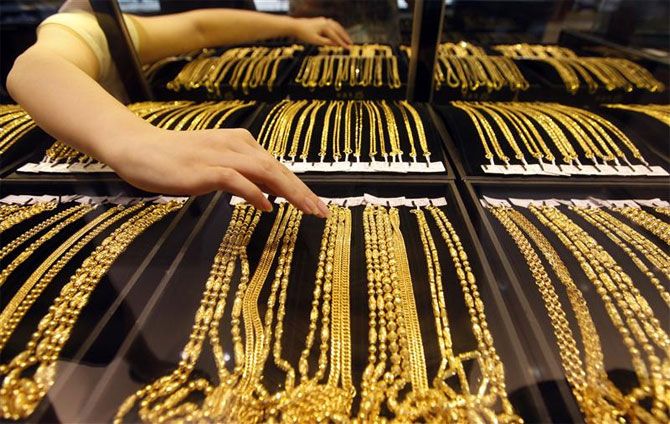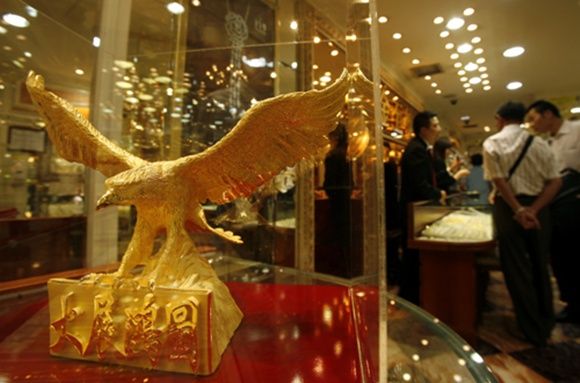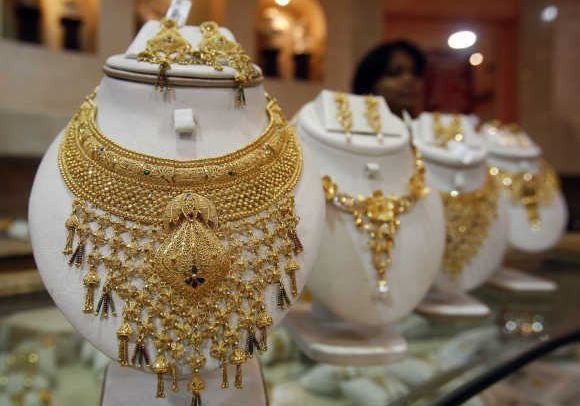'India has about 22,000 tonnes of private gold, held by individuals and temples.'
'Much of this is locked up in safes and vaults as a dead investment. If we can put the vast reserves of gold to use, it would boost the economy,' says V P Nandakumar, executive chairman, Manappuram Finance, India's first listed gold loan company.

Photograph: Babu/Reuters
India's love affair with gold grew stronger as it once again emerged as the world's biggest consumer of the precious metal beating China.
Bringing more cheer to the gold industry, the government eased import curbs by scrapping the '80:20' scheme. Under this scheme, 20 per cent of the imported gold had to be mandatorily exported before importing the new lot.
India imported a whopping 95,673 kg of gold in September, the highest level in the first six months of this financial year.
"The business of gold loans is about unleashing the hidden power of gold, bringing to life what is otherwise a dead investment," V P Nandakumar, executive chairman, Manappuram Finance Ltd -- the Rs 8,500 crore (Rs 85 billion) company, India's first listed gold loan company -- tells Shobha Warrier/Rediff.com

Photograph, courtesy: Manappuram Finance
How can the gold industry help the Indian economy bounce back?
The gold industry as a whole (including gold loans) can play a significant role to help the Indian economy grow.
The most recent estimate of the World Gold Council says that India has about 22,000 tonnes of private gold, held by individuals and temples. At current prices, this is close to a trillion dollars.
At the moment, much of these reserves are locked up in our safes and vaults as a dead investment. If we can put the vast reserves of gold to constructive use, it would be a major boost to the economy.

Photograph: Reuters
What course should the government follow?
The government and the Reserve Bank of India will have to take the lead to mobilise private gold to boost the mainstream economy.
Gold deposit schemes are a good idea, but they have to be made attractive. Currently, the schemes do not offer a high interest rate.
Also, the government should give immunity to individuals who are willing to bring private gold into the market as in most cases, private gold is unaccounted for.
India imports around 1,000 tonnes of gold annually. If you offer the gold that we have here in the market, we can curb imports and cut down smuggling.
It can also address the country's Current Account Deficit and fiscal deficit to some extent.
Monetisation of India's gold is about getting people to use gold as collateral when borrowing from banks and non-banking financial companies. In fact, this is what we do as a gold loan company.

Photograph: Bobby Yip/Reuters
The World Gold Council's target is to increase gold exports from $8 billion to $40 billion. Is it possible?
It is possible as we have excellent craftsmen in India. We can export ornaments to many countries. I am sure retailers would be ready to explore new markets and target the Indian Diaspora as well.
A leading jeweller told me that he is opening five new showrooms in the United States. He has plans to ultimately open 15 more.
He already has quite a few showrooms in Europe and London. His plan is to target the Asian Diaspora and later attract the locals as well.
We are importing gold even when tonnes of gold are not in circulation. Is it not a paradox?
In India, since the maximum quantity of gold is not in circulation, it doesn't add any value to the economy. If there is more competition in lending, it will reduce the interest rates considerably.
If that happens, it is likely that more people will start using their gold to start a business. However, the government must ensure that no taxman goes after these people asking for the source of their money.
That is why we need political will to bring gold into the market.
The big challenge is to get private gold into the financial system as deposits.
In other words, we should aim for a scenario where people who need money can use their gold to borrow, and those who don't need money can place their gold as deposits with the banks.
This gold can be sold in the domestic market to generate resources to finance infrastructure.

Photograph: Jayanta Dey/Reuters
The World Gold Council has said that the gold industry can create 5 million new jobs. Is this possible?
Over the next five years, this sector could double the number of people it employs.
At present, about 5 million are employed across the gold value chain from manufacturing to retailing, assaying and recycling.
If the government were to launch a suitable gold deposit scheme or gold bonds to garner funds for its infrastructure projects, many more jobs can be created in the assaying and recycling segments.
Today, much of our gold demand is met through imports which create mining and related jobs in the exporting country.
If we can make the shift to domestic recycled gold, many new jobs can be created within the country.




.jpg)





